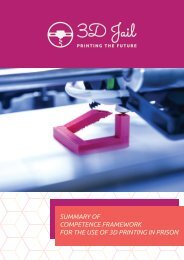3D Jail Project - IO1 - Competence framework for 3D printing in jail
Intellectual Output 1 The main innovative element of IO1 is to entail professionalizing competencies on the use of 3D printing technologies in the learning context of people with fewer opportunities because of their status of prisoners, ex-prisoners or subjected to alternative measures to detention. It is innovative because – in a pioneering way in Europe – it puts the basis to frame this kind of competencies in relation with restricted people, in the context of prison security, and it challenges penitentiary administrations to innovate their procedures and conditions to use even more ICT technologies inside their structures. It also poses prisons’ educational systems before the challenge to include these specific competencies in the educational experience of the inmates.
Intellectual Output 1 The main innovative element of IO1 is to entail professionalizing competencies on the use of 3D printing technologies in the learning context of people with fewer opportunities because of their status of prisoners, ex-prisoners or subjected to alternative measures to detention. It is innovative because – in a pioneering way in Europe – it puts the basis to frame this kind of competencies in relation with restricted people, in the context of prison security, and it challenges penitentiary administrations to innovate their procedures and conditions to use even more ICT technologies inside their structures. It also poses prisons’ educational systems before the challenge to include these specific competencies in the educational experience of the inmates.
- No tags were found...
You also want an ePaper? Increase the reach of your titles
YUMPU automatically turns print PDFs into web optimized ePapers that Google loves.
competitors. There are Industrial <strong>3D</strong> Pr<strong>in</strong>ters <strong>in</strong>tended <strong>for</strong> this, as the ones from the<br />
company “Tractus <strong>3D</strong>”.<br />
<strong>3D</strong> <strong>pr<strong>in</strong>t<strong>in</strong>g</strong> <strong>in</strong> prison can also be focused on <strong>pr<strong>in</strong>t<strong>in</strong>g</strong> items <strong>for</strong> the social good. An example<br />
of this would be the <strong>3D</strong> design and <strong>pr<strong>in</strong>t<strong>in</strong>g</strong> of low-cost customised prosthetic limbs, <strong>for</strong><br />
those who are <strong>in</strong> need and cannot pay <strong>for</strong> expensive bionic parts. This idea was carried<br />
<strong>for</strong>ward, <strong>for</strong> example, by the “Ayudame <strong>3D</strong>” project, which was founded <strong>in</strong> Spa<strong>in</strong>, and gives<br />
<strong>3D</strong>-pr<strong>in</strong>ted arms to people without resources from everywhere <strong>in</strong> the world, thus improv<strong>in</strong>g<br />
their life quality.<br />
Another example are companies that make <strong>3D</strong>-pr<strong>in</strong>ted ultrasound organ phantoms, help<strong>in</strong>g<br />
hospitals to prepare <strong>for</strong> surgical operations. Accord<strong>in</strong>g to the article “The Application of<br />
Ultrasound <strong>in</strong> <strong>3D</strong> Bio-Pr<strong>in</strong>t<strong>in</strong>g”, “three-dimensional (<strong>3D</strong>) bio<strong>pr<strong>in</strong>t<strong>in</strong>g</strong> is an emerg<strong>in</strong>g and<br />
promis<strong>in</strong>g technology <strong>in</strong> tissue eng<strong>in</strong>eer<strong>in</strong>g to construct tissues and organs <strong>for</strong><br />
implantation. Alignment of self-assembly cell spheroids that are used as bio <strong>in</strong>k could be<br />
very accurate after droplet ejection from biopr<strong>in</strong>ter. Complex and heterogeneous tissue<br />
structures could be built us<strong>in</strong>g rapid additive manufacture technology and multiple cell<br />
l<strong>in</strong>es”.<br />
Requirements of Software- and Hardware Skills<br />
In order to th<strong>in</strong>k about implement<strong>in</strong>g <strong>3D</strong>-<strong>pr<strong>in</strong>t<strong>in</strong>g</strong> workshops <strong>in</strong> prisons, it is essential to<br />
def<strong>in</strong>e the <strong>in</strong>itial background of both tra<strong>in</strong>ers and <strong>in</strong>mates, and what skills and competences<br />
they need as a base.<br />
Through the activities developed dur<strong>in</strong>g the first stage of the <strong>3D</strong> <strong>Jail</strong> project, the basic<br />
competences needed <strong>for</strong> both groups were determ<strong>in</strong>ed as follows:<br />
Inmates<br />
Responsibility<br />
Curiosity<br />
Perseverance<br />
Will to learn<br />
Good health<br />
Tra<strong>in</strong>ers<br />
Effective communication<br />
Experience <strong>in</strong> us<strong>in</strong>g CAD software and <strong>in</strong><br />
teach<strong>in</strong>g it<br />
Knowledge on how to motivate others<br />
Knowledge on the particular issues and<br />
characteristics of the prisons<br />
Capacity of adapt<strong>in</strong>g themselves to the<br />
prisons and the level of motivation and<br />
<strong>in</strong>tellectual skills of the <strong>in</strong>mates<br />
19





